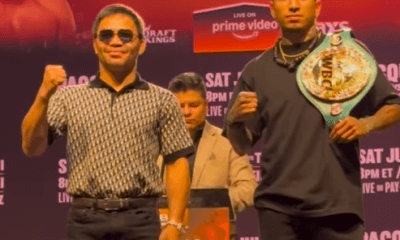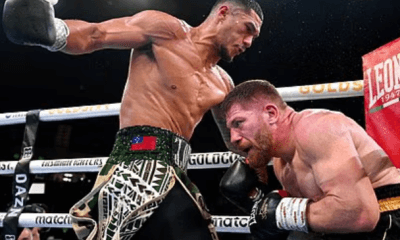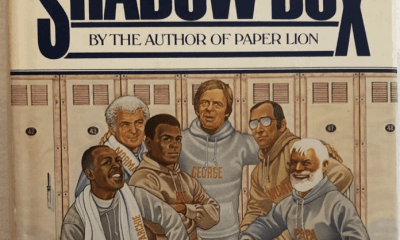Featured Articles
Finally, the Ring A Country For Young Men
 Khan and Garcia both made weight, both scaling in at 139 pounds ahead of their Saturday clash.
Khan and Garcia both made weight, both scaling in at 139 pounds ahead of their Saturday clash.
It was 12:30 a.m., a time when under normal circumstances this retired sports writer should have been sound asleep. But maybe it was the percussion made by the pelting rain upon the rooftop of my sister-in-law’s New Orleans-area condo, where the wife and I are spending a few pleasant weeks in our old hometown visiting with family members and friends before our return to Philadelphia. If not that, possibly it was a mild case of indigestion from the generous portion of spicy Cajun fare I consumed at dinner some hours earlier. In any case, I was up and about, mostly awake and wishing I wasn’t. So, naturally, I did what many occasional insomniacs do: I turned on the television set in the otherwise unoccupied living room to watch whichever was the best of the late-late movies on one of the 75 or so available cable channels.
As luck, or maybe fate, would have it, the pick of the litter was a more recent classic, No Country For Old Men, which won the 2007 Academy Award for Best Picture and starred the always watchable Tommy Lee Jones as a folksy, back-country 1980s Texas sheriff trying to make sense of a series of murders committed by a sociopathic killer from another part of the world, whose weapon of choice was highly unusual.
Nearly a week has passed since that rainy night, and as I sit here pondering the approach I will take to the story I am about to write, it occurs to me that there might be an inspired reason why I awoke when I did, and elected to sit through the 2½ -hour entirety (including commercials) of a movie I already had watched probably seven or eight times.
Unlike most areas of our youth-obsessed culture, boxing is indeed a country for old men, which perhaps has contributed to the sport’s failure to attract as many new devotees as, say, mixed martial arts or the X-Games, where nut cases on skateboards and dirt bikes risk their health performing daredevil maneuvers without ever having to take a punch. In an era in which it is increasingly difficult to identify potential superstar fighters in their 20s, and some of the best-known practitioners of the pugilistic arts continue to be such fortysomethings as Bernard Hopkins, Roy Jones Jr., Evander Holyfield and James Toney, even our interminable wait for a pairing of 35-year-old Floyd Mayweather Jr. and 33-year-old Manny Pacquiao almost qualifies as a dream showdown of ascending talents.
All of which stamps Saturday night’s super lightweight matchup of WBC champion Danny “Swift” Garcia (23-0, 14 KOs) and former WBA and IBF 140-pound titlist Amir “King” Khan (26-2, 18 KOs), at the Mandalay Bay Events Center in Las Vegas, as the boxing equivalent, or close to it, of Kevin Durant vs. LeBron James in the NBA Finals, or wunderkinds Bryce Harper vs. Mike Trout in some World Series in the not-so-distant future.
All right, so Garcia, 24, and Khan, 25, aren’t yet members of the highly exclusive and ever-shrinking fraternity of boxing superstars. Part of that is attributable to the fact their professional development hasn’t been as accessible to the public as were those of Sugar Ray Leonard and Thomas Hearns, whose meteoric rises in their formative professional stages owed in no small part to receiving regular exposure on free, over-the-air network television. The best, most anticipated scraps now are almost always on premium-cable or pay-per-view, freezing out thrifty fans on a budget who don’t subscribe to HBO or Showtime, or, even if they did, would prefer not to receive PPV-inflated monthly cable bills the size of new-car installment notes.
When Hearns was inducted into the International Boxing Hall of Fame in Canastota, N.Y., on June 10, thousands of middle-aged idolators turned out to see him, Leonard and Marvelous Marvin Hagler share the dais, serving as reminders of a golden age that has passed and isn’t that likely to come around again unless certain parameters of the game can be changed. Part of that process is the need for promoters to expose the lead ponies in their respective stables to the type of risky showdowns that tend to jeopardize unblemished records and alphabet titles, as fabricated as those distinctions might be. It seems hard to believe now, but Leonard was only 25 when he took his 30-1 record into the ring on Sept. 16, 1981, at Caesars Palace against Hearns, who was 32-0 and still a month shy of his 23rd birthday. Oh, sure, Leonard embellished his burgeoning legend with a come-from-behind 14th-round stoppage of the very game “Hit Man,” but Hearns performed well enough that that defeat did not erode his popularity, just as his damn-the-torpedoes loss to Hagler in their 1985 slugfest also served to elevate his status as an all-time great rather than to take it down a notch.
It didn’t hurt, of course, that Garcia, who captured the vacant WBC crown on March 24 with his unanimous decision over faded icon Erik Morales (who had relinquished the title a day earlier when he failed to make weight), and Khan both are promoted by Golden Boy, making the negotiations less confrontational than is frequently the case. Also facilitating matters is the fact that Khan, who had been preparing for a late-May rematch with the man who had wrested the WBA and IBF titles from him on a controversial split decision, Lamont Peterson, tested positive for steroids and was stripped of those belts.
Mostly, though, this appealing bout, which will be televised by HBO, was made because two young, hungry and confident fighters wanted to test themselves against someone who brought many of the same attributes to the table, and because each knows the only way to step up to the threshold of superstardom is to say what the hell and take a chance now, when it actually means something.
“I felt it was a big opportunity,” said Garcia. “Khan was supposed to fight Peterson again, but when that fell through, my manager (Al Haymon) reached out to me and said, `Do you want to fight the guy? I know you can beat him.’ I said, `Yeah, I know I can beat him, too, so let’s do it.’
“I’ve watched Khan for years. I never thought he was as good as people were making him out to be. Boxing is too political sometimes. Fighters get to be champions and all of a sudden they or their managers just want to play it safe so they can hold onto the title for a long time. Boxing needs to get exciting again, with more fights between two young, strong, fast guys in their primes.
“I didn’t have to take this fight. I could have gone another way. But I heard what was being said after I won the WBC championship. `Danny Garcia beat an old man.’ It was like I wasn’t getting the credit I believed I deserved. That’s why I said yes to a fight with Khan. I want to show the world that I’m the real deal, and I’m going to be on top for a long time.”
Those sentiments were more or less echoed by Khan, who is thrilled that at least one of his former 140-pound titles, the WBA version, also will be on the line on Saturday night, the WBA having tossed its hardware into the pot as a result of Peterson testing dirty.
“We spoke to Golden Boy (CEO Richard Schaefer) and he said, `What do you think of Danny Garcia (as a replacement opponent)? I jumped to the occasion. I remember watching the highlights when Garcia beat Erik Morales. He’s a good fighter and he has a name that I thought would be in my future because he’s young, he’s good and he’s strong. I thought, `I’m going to have to keep an eye on this guy.’
“I would have liked to settle the score properly (with Peterson), but Garcia and I have similar speed and similar movements. We’re both unorthodox. And having two world titles on the line makes the fight even bigger.”
As well thought of as Garcia was prior to his conquest of Morales (he was a 2005 Under-19 U.S. champion and a 2006 U.S. national champion as an amateur), he didn’t enter the pro ranks as heavily hyped as was Khan, a silver medalist for Great Britain at the tender age of 17 at the 2004 Athens Olympics. Boxing writers from the United Kingdom had been rhapsodizing about him to their American counterparts for years, touting Khan, who is of Pakistani descent, as the second coming of “Prince” Naseem Hamed. And when Khan took out the great Marco Antonio Barrera, or what remained of him, in five rounds on March 14, 2009, in Manchester, England, it served to largely erase the memory of his shocking, first-round knockout by Breidis Prescott two bouts earlier, also in Manchester.
Despite those two defeats on his resume, Khan is anywhere from a 3½ -1 to a 6-1 favorite, depending on which wagering establishment is setting the odds. The extent of Garcia’s longshot status does seem a bit wide, but that could be the result of all those vocal and free-spending Brits putting next month’s rent money on their hero, whereas Garcia still is trying to expand his base of support. A victory over Khan would do much to further his ambitions to be recognized as top-tier fighter and bankable attraction.
It remains to be seen whether either Garcia or Khan, or both, ever rise to the prominence of a Leonard or a Hearns, although the suspicion is that much work needs to be done for them to even enter that discussion. But they are young guns willing to back up their conviction in themselves where it counts, inside the ropes.
For that, fights fans of all ages should be grateful.
-

 Featured Articles3 weeks ago
Featured Articles3 weeks agoAvila Perspective, Chap. 330: Matchroom in New York plus the Latest on Canelo-Crawford
-

 Featured Articles2 weeks ago
Featured Articles2 weeks agoVito Mielnicki Jr Whitewashes Kamil Gardzielik Before the Home Folks in Newark
-

 Featured Articles4 weeks ago
Featured Articles4 weeks agoAvila Perspective, Chap 329: Pacquiao is Back, Fabio in England and More
-

 Featured Articles3 weeks ago
Featured Articles3 weeks agoOpetaia and Nakatani Crush Overmatched Foes, Capping Off a Wild Boxing Weekend
-

 Featured Articles2 weeks ago
Featured Articles2 weeks agoCatching Up with Clay Moyle Who Talks About His Massive Collection of Boxing Books
-

 Featured Articles4 weeks ago
Featured Articles4 weeks agoFabio Wardley Comes from Behind to KO Justis Huni
-

 Featured Articles1 week ago
Featured Articles1 week agoMore Medals for Hawaii’s Patricio Family at the USA Boxing Summer Festival
-

 Featured Articles4 weeks ago
Featured Articles4 weeks agoDelving into ‘Hoopla’ with Notes on Books by George Plimpton and Joyce Carol Oates















